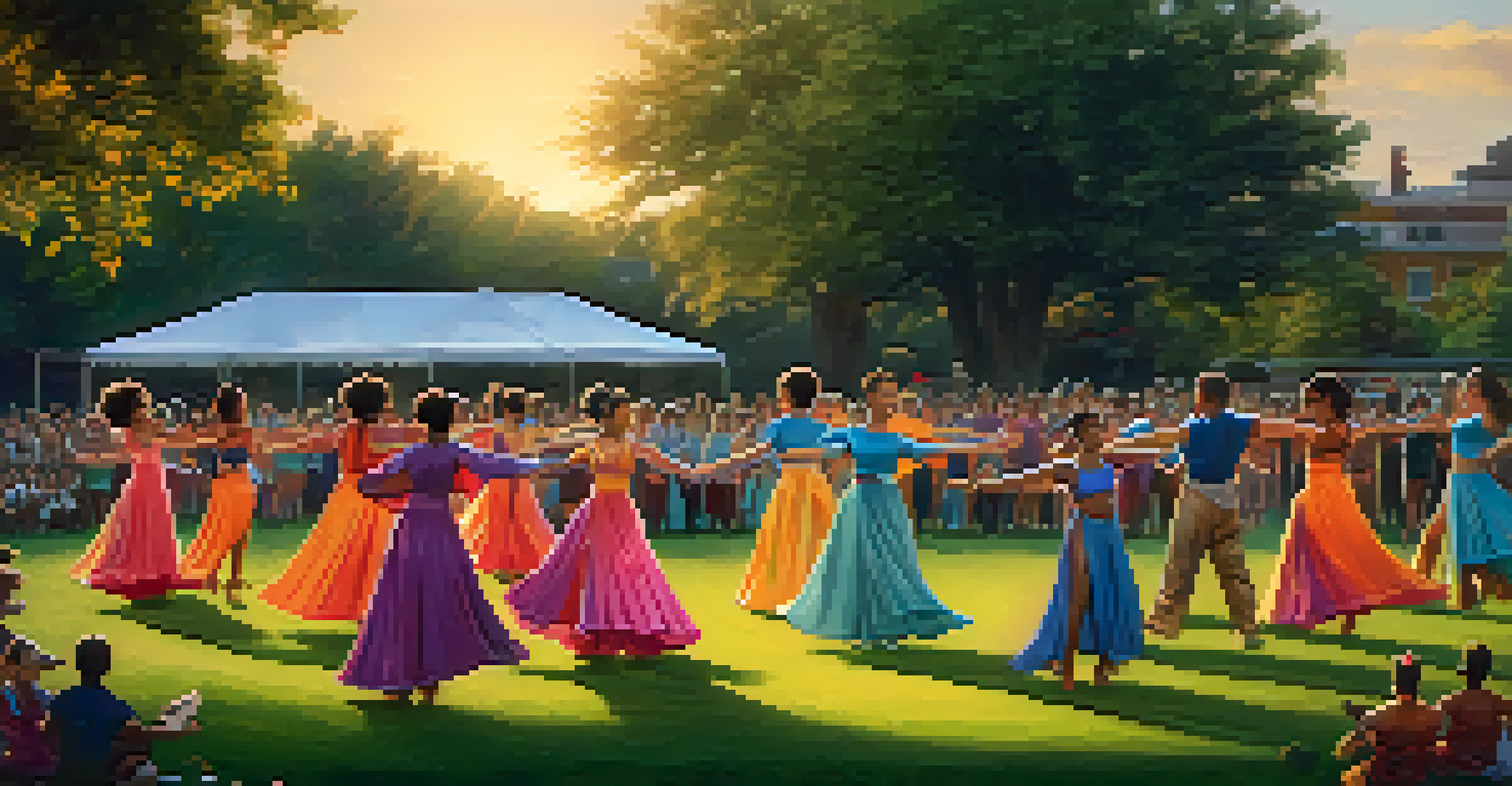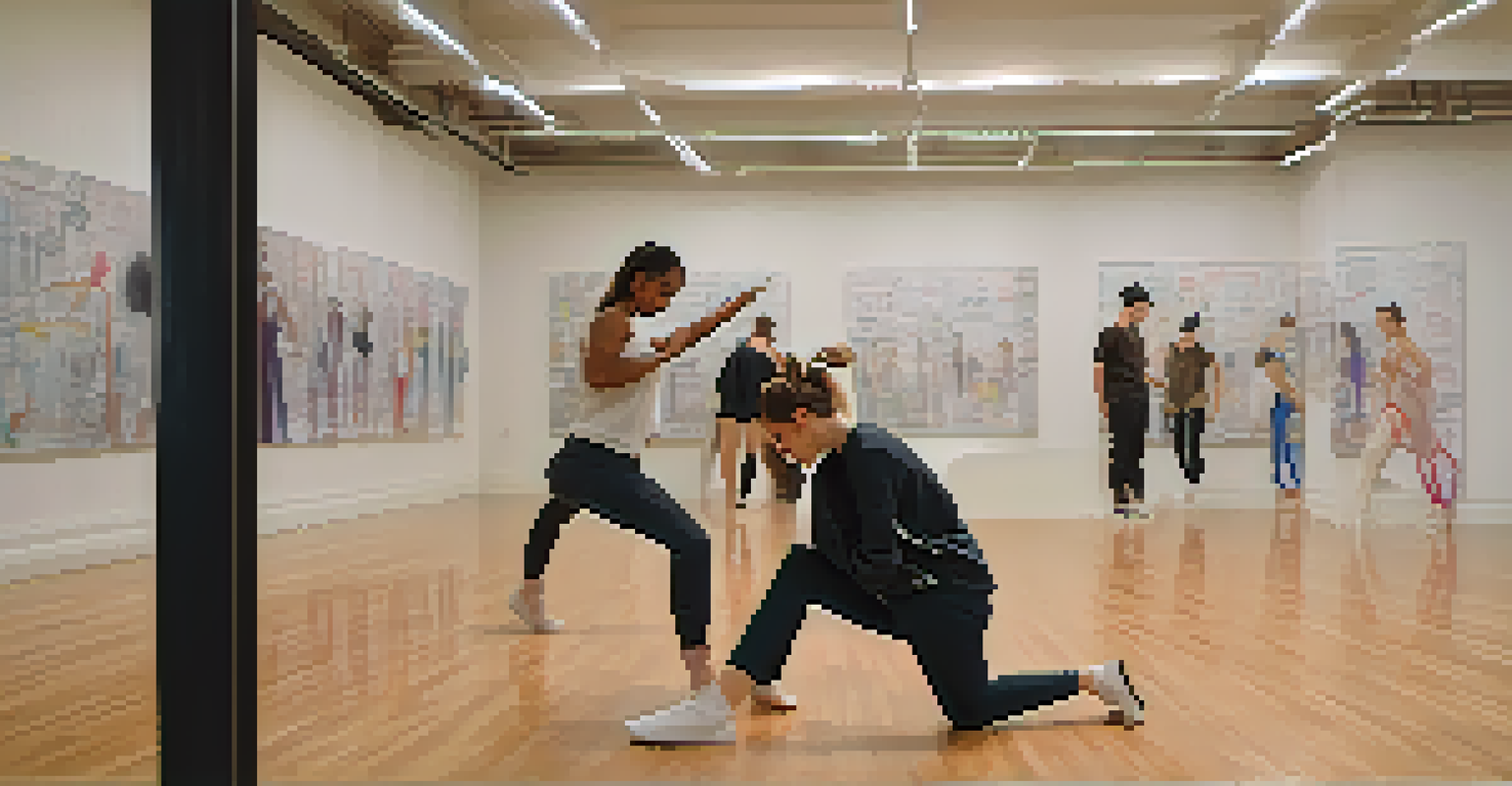Creating Inclusive Choreography: Embracing Diversity in Dance

Understanding the Importance of Inclusivity in Dance
Inclusivity in dance goes beyond just welcoming different body types; it's about creating a space where everyone feels valued. When choreographers embrace diverse backgrounds and experiences, they enrich the dance community as a whole. This approach not only reflects societal diversity but also enhances creativity, leading to richer performances that resonate with wider audiences.
Dance is the hidden language of the soul.
Think of a dance piece as a tapestry, where each unique thread contributes to the overall beauty. If every thread were the same, the tapestry would lose its vibrancy. By incorporating different cultures, abilities, and perspectives, choreographers can craft performances that tell multifaceted stories, drawing in viewers from all walks of life.
Moreover, fostering an inclusive environment encourages participation from underrepresented groups. When dancers see themselves reflected in choreography, they are more likely to engage and share their experiences, ultimately strengthening the dance community.
Recognizing Diverse Dance Styles and Traditions
Every culture has its unique dance traditions, each telling stories and conveying emotions in distinct ways. By recognizing and integrating these styles into choreography, artists can create a richer, more inclusive performance. For instance, blending African dance with contemporary movements can yield a captivating piece that pays homage to both traditions.

It's essential to approach these styles with respect and understanding. Engaging with cultural representatives, learning their histories, and honoring their significance ensures that the choreography is authentic and not appropriative. This respectful blending can foster deeper connections among dancers and audiences alike.
Embracing Diversity Enriches Dance
Incorporating diverse backgrounds and experiences in dance creates a vibrant community and enhances creativity.
Additionally, incorporating various dance forms can challenge conventional norms within the dance world. This not only broadens the artistic palette but also inspires dancers to explore new techniques and narratives, ultimately resulting in more innovative choreography.
Creating Accessible Dance Spaces for All Abilities
Accessibility in dance means ensuring that everyone, regardless of physical ability, can participate and enjoy the art form. This can involve modifying spaces, offering adaptive techniques, and providing resources that cater to diverse needs. For example, using a variety of props or creating seated dance options can make a huge difference for those with mobility challenges.
In diversity there is beauty and there is strength.
Consider the joy of a dancer who finally feels included in a class or performance due to thoughtful adaptations. Their passion can inspire others and contribute to a more vibrant dance community. Ensuring that spaces are accessible not only benefits individuals but also enriches the entire group through shared experiences.
Moreover, promoting inclusivity in dance education can foster a generation of choreographers who prioritize accessibility as they develop their own styles. By instilling these values early on, we can cultivate a culture of inclusivity that continues to flourish in future generations.
Fostering an Inclusive Choreographic Process
An inclusive choreographic process involves collaboration and open communication among all participants. Encouraging input from dancers during the creation process can lead to innovative ideas and solutions that reflect diverse perspectives. For instance, a choreographer might ask dancers to suggest movements that resonate with their cultural backgrounds, leading to a more authentic piece.
Creating a safe space for feedback is crucial. When dancers feel comfortable sharing their thoughts, it can spark creativity and ensure that everyone’s voice is heard. This collaborative spirit not only enhances the choreography but also builds stronger bonds among dancers, fostering a sense of community.
Accessibility Benefits All Dancers
Creating accessible dance spaces fosters participation and enriches the entire community through shared experiences.
Moreover, incorporating diverse choreographers into the creative process can further enrich the work. Each choreographer brings their unique experiences and viewpoints, creating a dynamic that results in innovative, inclusive performances that captivate audiences.
Utilizing Technology to Enhance Inclusivity in Dance
In today's digital age, technology can play a vital role in promoting inclusivity in dance. Virtual classes and online platforms allow dancers from various backgrounds and locations to connect and learn together. This accessibility can help break down geographical barriers and create opportunities for collaboration and exchange of ideas.
Additionally, using technology like video analysis can help dancers of all abilities improve their skills. By providing visual feedback, choreographers can tailor their instruction to meet individual needs, ensuring everyone progresses at their own pace. This personalized approach can enhance the learning experience and foster a greater sense of belonging.
Moreover, social media platforms can amplify diverse voices in the dance community. By sharing performances, stories, and experiences, dancers can inspire others and create a supportive network that celebrates inclusivity. This virtual community can influence the broader dance world, promoting acceptance and understanding.
Highlighting the Role of Educators in Promoting Inclusivity
Dance educators play a crucial role in shaping an inclusive environment. By incorporating diverse perspectives into their teaching methods, they can inspire students to appreciate various dance forms and cultures. Educators can encourage students to explore their unique voices, fostering a sense of pride in their identities.
Moreover, professional development opportunities focused on inclusivity can equip educators with the tools they need to create supportive environments. Workshops that emphasize adaptive techniques or culturally responsive teaching can empower educators to better serve their diverse student populations. As they gain these insights, they can pass them on to their students, creating a ripple effect.
Educators Shape Inclusive Futures
Dance educators play a crucial role in promoting inclusivity by teaching diverse perspectives and adaptive techniques.
Ultimately, the impact of inclusive educators extends beyond the classroom. By instilling values of acceptance and respect, they help shape the future of the dance community, ensuring that it continues to grow and evolve in a way that celebrates diversity.
Celebrating Success Stories of Inclusive Choreography
Highlighting success stories of inclusive choreography can inspire others to embrace diversity in their work. For instance, consider a dance company that integrates dancers with disabilities into their performances, showcasing their unique talents and perspectives. These stories not only spotlight the beauty of inclusivity but also demonstrate the powerful impact it can have on audiences.
By sharing these narratives, we can motivate choreographers and dancers to push boundaries and explore new creative avenues. Celebrating the achievements of inclusive dance projects raises awareness and encourages others to take similar steps toward fostering inclusivity in their own work.

Additionally, showcasing inclusive choreography at festivals or competitions can further validate these efforts. When diverse performances receive recognition, it sends a clear message that inclusivity is not just a trend, but a vital aspect of the dance community that deserves celebration and support.